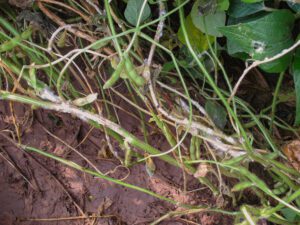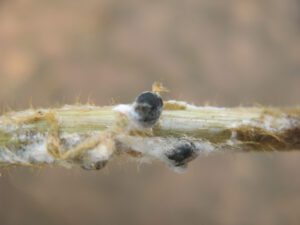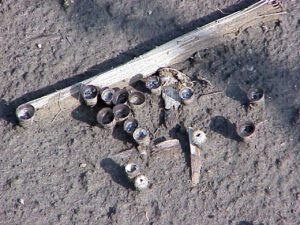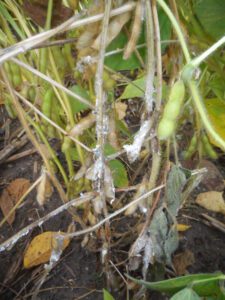 Soybean white mold is an annual threat in the northern United States (north of Interstate 70) from Nebraska to the Atlantic Coast, though it may appear anywhere when conditions are right.
Soybean white mold is an annual threat in the northern United States (north of Interstate 70) from Nebraska to the Atlantic Coast, though it may appear anywhere when conditions are right.
Jason Gibson, market development specialist, Corteva Agriscience, says white mold in soybeans is one disease that should be on your radar this year. “Areas that were significantly impacted by white mold in 2021 will likely be planted to soybeans again this year,” he says.
University of Wisconsin-Madison has developed models to forecast disease risk. You can enter operation-specific information, and the application will help identify the best timing for disease treatment in your fields. Gibson recommends using Sporecaster for white mold.
Timely, preventive action is necessary to maximize yield in the presence of white mold. Geographic location is only one piece of the puzzle. Also consider spring climate, planting practices, soybean variety, microclimate and field history when weighing the potential of white mold development.
Timing
Cool, wet conditions during spring flowering (R1) are ideal for white mold growth. These conditions that increase disease risk include:
- Temperatures below 85 F
- Frequent rain
- High relative humidity
Management tips
Most severe infestations are found in denser, faster-closing varieties. While no variety has absolute resistance, some varieties offer varying levels of resistance to white mold.
Practices that accelerate canopy development and enhance yield potential can increase risk of infection, including:
- Early planting
- Narrow rows
- High seeding densities
- High soil fertility
Impact on yield
Harvest on or near infected fields with care, since white mold is easily spread. Sclerotia form within and on the outside of plant stems, then drop to the soil surface during harvest. They can be present in harvested soybeans, but are not toxic to livestock and the fungus should be killed during the roasting process.
Because sclerotia are released during the harvesting process, they can easily be spread to new fields. Harvest infected fields last and thoroughly clean equipment when leaving infected fields.
Under ideal disease conditions, it only takes one soybean crop to jump from 5 or 10 percent infected soybean plants in a field to 50 percent the following season. Correct disease diagnosis and implementing an effective management strategy before harvest will help minimize the spread of sclerotia and reduce the risk of severe disease in subsequent years.
Symptoms white mold disease cycle:
 Sclerotia
Sclerotia
Sclerotia are dark, irregularly shaped white mold survival structures. Resembling mouse droppings, they function much like seeds, protecting the organism until conditions allow it to germinate.
About ¼ to ½ inch long, sclerotia form within the white, cottony growth inside and outside soybean stems. Within these structures, the disease survives in soil for up to 10 years.
Only sclerotia within 2 inches of the soil surface can germinate.
Tilling infected fields can bring deeper sclerotia to the surface and propagate the disease.
When conditions are right, sclerotia germinate and produce apothecia.
 Apothecia
Apothecia
Apothecia are tan, spongy, mushroom-like structures that grow from sclerotia. At full maturity, they reach ¼ to ½ inch in length. They can be found beneath soybean canopies on or just below the soil surface when soil is moist and dim light reaches through the canopy.
The quantity of apothecia is relative to the number of sclerotia near the soil surface when necessary environmental conditions are met. Apothecia can form under the canopies of non-host plants, such as corn, small grains and forage legumes.
Many other mushrooms grow in soybean fields, including birdnest mushroom. Correct diagnosis is critical to implementing an effective management program.
When conditions favor white mold development, a small number of apothecia can infect a relatively significant number of soybean plants as they release airborne spores.
Spores
Spores are produced under the cap of apothecia. Each apothecium can release more than 10 million microscopic spores over several days, which are carried by the wind to surrounding plants. After release, spores survive for only a few days.
Spores land on senescing soybean blossoms and are able to germinate within soybean plants during a period of prolonged leaf wetness (16 to 48 hours).
 Soybean plants
Soybean plants
Soybean plants are most vulnerable to white mold infection during bloom phase. With adequate moisture, airborne spores that land on surrounding plants use senescing petals as the gateway to infecting the plant. Plant-to-plant infection is possible, but not common.
Once fungal spores germinate on petals, the infection is able to spread throughout the plant to pods, nodes and stems.
Infection
Infection signs are not immediately visible. The obvious signs may be apparent within 3 to 4 weeks of infection, but generally go unnoticed for another week or more.
Check stems of potentially infected plants to diagnose white mold. The first signs are gray to white lesions at nodes. Lesions rapidly spread above and below infected nodes and are often covered in fluffy, white growths.
Diagnosing white mold by foliar damage is not reliable. Wilted leaves die and turn brown, but often remain attached to the stem past maturity.
These signs of foliar damage are similar to other diseases, including stem rot, Phytophthora root rot, sudden death syndrome and stem canker. Stems should be inspected to confirm white mold diagnosis.
If you have any questions about white mold, contact Louis, our Agronomy Lead, or reach out to your local independent seed company.


